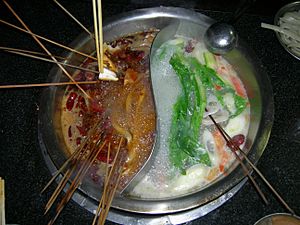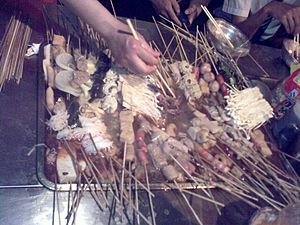Malatang facts for kids
Quick facts for kids Malatang |
|||||||||||||
|---|---|---|---|---|---|---|---|---|---|---|---|---|---|
 |
|||||||||||||
| Traditional Chinese | 麻辣燙 | ||||||||||||
| Simplified Chinese | 麻辣烫 | ||||||||||||
| Literal meaning | spicy numbing hot | ||||||||||||
|
|||||||||||||
Malatang is a popular Chinese street food. It's a bit like a spicy, numbing hot soup. This dish first came from Sichuan, China. It's different from traditional hot pot because hot pot is usually shared at a table. Malatang is more like a quick meal you can grab and eat on the go.
The Chinese government officially calls it "Spicy Hot Pot" in English. But most people still use the name "Malatang" because it's become a well-known word around the world!
Contents
What Does Malatang Mean?
Malatang gets its name from its main flavor: mala sauce. The word málà means "numbing" (麻) and "spicy" (辣) in Chinese. This describes the special feeling you get in your mouth when you eat it. It's a mix of Sichuan pepper and dried Chili peppers.
Where Did Malatang Come From?
Malatang is thought to have started near the Yangtze River in Sichuan. Long ago, many people worked on boats, pulling them along the river. The weather was often damp and foggy, which made them feel unwell. To warm up and feel better, they would cook herbs in a pot. They added Sichuan pepper and ginger to the soup. This helped them fight off the dampness.
This simple meal was the beginning of Malatang. Soon, street vendors saw a chance to sell this tasty, warming food. They started making it for others, and it quickly spread across China.
How Is Malatang Different from Hot Pot?
Unlike hot pot, which is usually a big meal shared by a group at a restaurant, Malatang started as a quick street food. It's cooked in a large pot for everyone to share. You can quickly pick what you want to eat. Then, you can either enjoy it right there or take it with you.
How Is Malatang Made?
There are two main ways Malatang is prepared today.
Malatang on Skewers
In some places, you'll find a big, flat pot set up on the street. Many different ingredients are cooking in a mildly spicy soup. These ingredients are usually on wooden skewers. Customers sit around the pot and pick out whatever skewers they want to eat.
Because there are so many choices, not all ingredients are in the pot at once. If you want something specific, you can ask for it to be added. All skewers usually cost the same amount. For example, in Beijing, they used to cost about one Chinese Yuan (RMB) each. When you finish eating, the seller counts your empty sticks to figure out your bill.
Malatang by Weight
In the mid-2010s, Malatang shops became very popular, especially in northern China like Beijing. In these shops, you'll see shelves filled with ingredients. You grab a bowl and choose all the vegetables, meats, and noodles you want.
After you pick your ingredients, they are taken behind the counter. A chef cooks them quickly in a spicy broth, usually for just 3 or 4 minutes. Before your bowl is served, it's often seasoned with extra garlic, black pepper, Sichuan pepper, chili pepper, sesame paste, and crushed peanuts. The price is based on how much your chosen ingredients weigh. In Beijing, half a kilogram often costs between 15 and 20 RMB.
Common Malatang Ingredients
You can find many different things to add to your Malatang. Here are some common choices:
- wosun (a type of lettuce)
- Beef chunks
- Dumplings
- Lettuce
- Spinach
- Other mixed greens
- Lotus root
- Mushrooms
- Fresh and instant noodles
- Pork liver
- Pork lung
- Potato
- Quail eggs
- Spam
- Chinese yam
- Sheep intestines
- Many types of dried and frozen tofu
- Nian gao rice cakes
- Beef balls
- Fish balls
- Chicken balls
- Sweet potato
- Tripe




